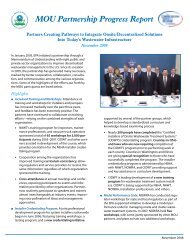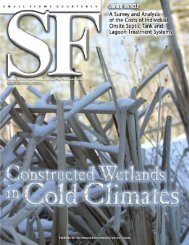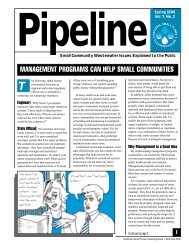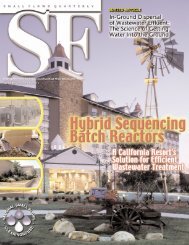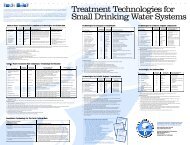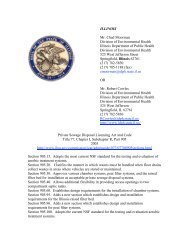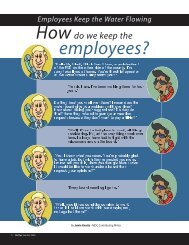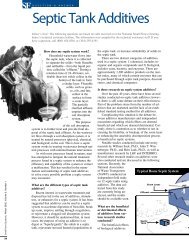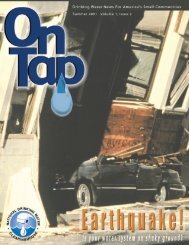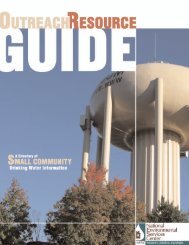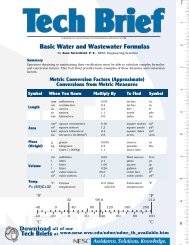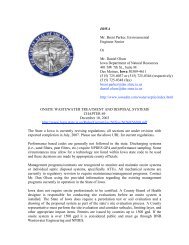Download - National Environmental Services Center - West Virginia ...
Download - National Environmental Services Center - West Virginia ...
Download - National Environmental Services Center - West Virginia ...
Create successful ePaper yourself
Turn your PDF publications into a flip-book with our unique Google optimized e-Paper software.
TABLE 1<br />
Wastewater Treatment Plant and Community Data for North Bosque Communities<br />
J U R I E D A R T I C L E<br />
Small Flows Quarterly, Fall 2004, Volume 5, Number 4<br />
Table 1 presents various community<br />
and WWTP data for the<br />
six North Bosque communities. To<br />
assist comparison, communities<br />
are ordered from left to right<br />
based on descending order of population.<br />
Populations of North<br />
Bosque communities vary considerably.<br />
The largest community,<br />
Stephenville, had a population of<br />
around 15,000 (U.S. Census,<br />
2000), while populations were<br />
considerably smaller for the remaining<br />
five North Bosque communities,<br />
ranging from 360 to<br />
about 3,500 (U.S. Census, 2000).<br />
Sewer hookups for the six<br />
North Bosque communities are<br />
classified into single family residential,<br />
multi-unit residential, and<br />
commercial. Number of hookups<br />
and the distribution of sewer<br />
usage by sewer hookup classification<br />
(Table 1) was collected from<br />
North Bosque communities and<br />
was used to calculate affordability<br />
measures. Sewer usage is defined<br />
as amount of effluent attributed to<br />
each hookup classification and is<br />
stated as a percent of total.<br />
Actual and permitted flows at<br />
North Bosque WWTPs (Table 1)<br />
are consistent with their populations<br />
and commercial usage. Permitted<br />
flows ranged from 0.05<br />
mgd (189 m3/d) to 3.0 mgd<br />
(11,400 m3/d) for the Iredell and<br />
Stephenville plants, respectively,<br />
while actual flows ranged from<br />
0.03 mgd (95 m3/d) to 1.4 mgd<br />
(5,200 m3/d). Measured mean TP<br />
concentrations at WWTP outfalls,<br />
based on grab samples collected<br />
by the Texas Institute for Applied<br />
<strong>Environmental</strong> Research (TIAER)<br />
between 1993 and 2001, ranged<br />
from 2.4 mg/L to 3.5 mg/L (Table<br />
1). These ending effluent concentrations<br />
are thought to be typical<br />
for WWTPs that are not specifically<br />
removing nutrients by tertiary<br />
chemical or biological treatment.<br />
Ending effluent levels, however,<br />
are all considerably higher than 1<br />
mg/L—the concentration limit of<br />
the control action considered.<br />
CDM (2001) considered the following<br />
four major treatment alternatives<br />
for reducing phosphorus<br />
at North Bosque WWTPs:<br />
chemical treatment, biological<br />
treatment with chemical polishing,<br />
wetlands treatment, and land<br />
treatment. Wetlands treatment<br />
did not appear to be cost-effective<br />
for North Bosque WWTPs because<br />
of the large pond areas required<br />
(CDM, 2001). Land treatment<br />
may have been feasible for the<br />
smaller North Bosque River plants<br />
but would have required additional<br />
detailed site-specific investigations<br />
that were not pursued.<br />
Chemical removal by an iron<br />
or aluminum based precipitate<br />
and biological removal are the<br />
two most widespread forms of<br />
phosphorus removal and were<br />
considered feasible for all North<br />
Bosque WWTPs. Biological nutri-<br />
ent removal has become widespread<br />
at WWTPs across the U.S.,<br />
but is often not cost-effective for<br />
small WWTPs. Chemical addition<br />
utilizing aluminum sulfate (alum)<br />
addition is the phosphorus removal<br />
method most often used in<br />
central Texas (Miertschin, 1999;<br />
CDM, 2001). This study confines<br />
its analysis to phosphorus removal<br />
utilizing alum addition as the primary<br />
supplemental removal<br />
mechanism. Estimated costs of biological<br />
treatment by CDM (2001)<br />
are higher than those of phosphorus<br />
removal utilizing alum, as estimated<br />
in this report, for all plants.<br />
Costs of Phosphorus<br />
Removal<br />
During TMDL deliberation, a<br />
generic engineering study of phosphorus<br />
removal costs was conducted<br />
(Miertschin, 1999) followed by<br />
a site-specific study for the six<br />
North Bosque WWTPs sponsored<br />
by the Brazos River Authority<br />
(CDM, 2001). Costs for several specific<br />
items for this study are based<br />
on the site-specific analysis. The<br />
methodology used in this study,<br />
however, departed from the sitespecific<br />
study in that near-term<br />
costs of phosphorus removal under<br />
current conditions (versus the estimation<br />
of costs based on design<br />
parameters) were estimated. Costs<br />
were divided into two major categories:<br />
operation and maintenance<br />
costs, and capital costs.<br />
40




